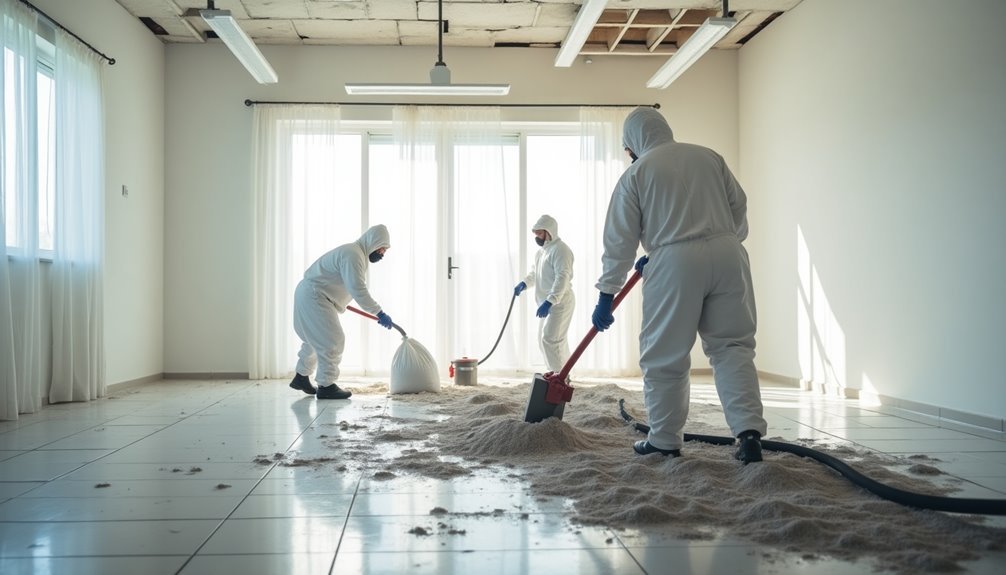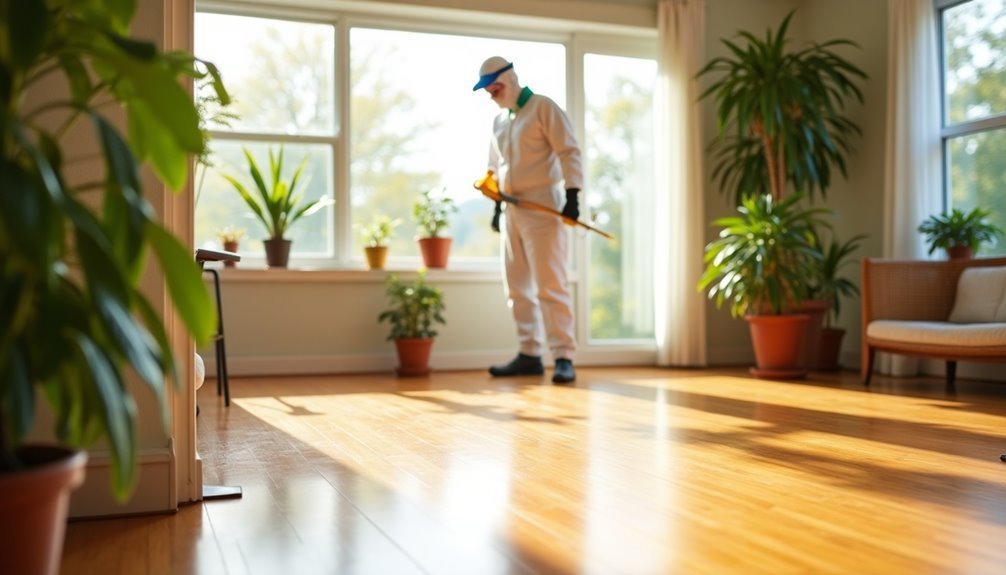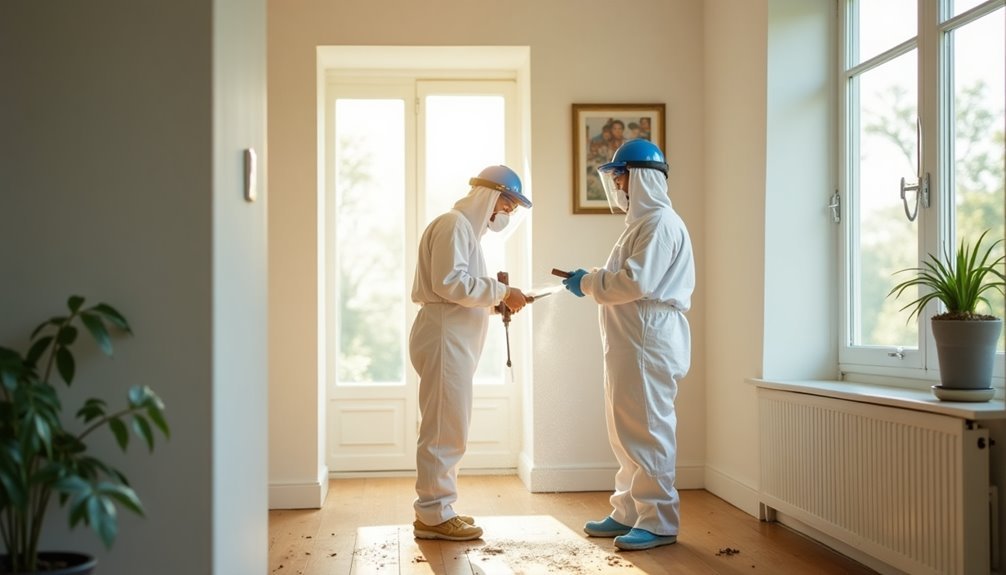Asbestos abatement services help you create a safer, healthier home by removing or containing hazardous asbestos materials. This minimizes the risk of serious health issues such as lung cancer and mesothelioma for you and your family. Professional abatement includes thorough cleaning and air quality testing, ensuring a safe environment. You'll also benefit from compliance with local and federal regulations, reducing potential legal risks and boosting your property's value. Effective disposal methods prevent environmental contamination, contributing to long-term safety. Understanding these components is crucial for maintaining a healthy living space, and there's much more to explore about this essential service.
Health and Safety Benefits

Asbestos abatement services offer crucial health and safety benefits, significantly reducing the risk of asbestos-related diseases. When you engage professionals for asbestos removal, you're taking a proactive step towards eliminating exposure to harmful asbestos fibers. These fibers can lead to serious conditions like asbestosis, mesothelioma, and lung cancer, which may take years to manifest, complicating early detection.
By ensuring that asbestos-containing materials (ACMs) are properly removed or contained, you protect the health of everyone in your environment. This process not only minimizes immediate risks but also fosters long-term health by creating safer living and working spaces. Professional abatement includes thorough cleaning and air quality testing, confirming that the area is free from harmful fibers. Additionally, effective management of asbestos ensures safe disposal of materials, preventing environmental contamination and promoting a healthier community.
Moreover, health education and risk awareness are integral components of these services, empowering you and your community to recognize potential hazards and make informed decisions. Understanding the risks associated with asbestos fosters a culture of safety, ensuring that everyone is aware of the importance of maintaining a healthy environment. In short, investing in asbestos abatement is a commitment to safeguarding your health and the well-being of those around you.
Compliance With Regulations
Navigating the complex landscape of compliance regulations is essential for anyone involved in asbestos abatement. You'll face various regulatory updates at federal, state, and local levels, each imposing specific requirements. Understanding these regulations helps you avoid compliance challenges that could lead to legal issues or penalties.
Consider these key points:
- Federal Regulations: The NESHAP outlines strict work practices for asbestos during renovations. You must notify state agencies before starting any work.
- State Regulations: In New York, licensing is mandatory for abatement contractors, with potential penalties for non-compliance.
- Local Regulations: New York City requires a seven-day notification prior to abatement activities and mandates an abatement plan.
Being aware of the permitting and notification processes is crucial. It's not just about compliance; it's about protecting your home and health. You'll want to ensure all necessary permits are obtained, and notification protocols are followed. By prioritizing adherence to these regulations, you empower yourself to manage asbestos risks effectively and create a safer living environment. Remember, staying informed and compliant isn't just a legal obligation—it's a pathway to liberation from health hazards. Additionally, understanding the health risks associated with asbestos helps emphasize the importance of these regulations in safeguarding your well-being.
Proper Abatement Techniques

When it comes to asbestos abatement, choosing effective removal methods is crucial for minimizing risks. You'll need to ensure the proper usage of safety equipment to protect both workers and occupants. Additionally, conducting a thorough risk assessment before beginning the process can significantly enhance safety and compliance throughout the project.
Effective Removal Methods
Effective removal methods for asbestos abatement require meticulous planning and execution to ensure safety and compliance. You'll want to start by preparing and isolating the work area properly. This includes erecting barriers and sealing off spaces to prevent unauthorized access and contamination.
When it comes to actual removal, employing wet removal techniques is crucial. By saturating asbestos-containing materials (ACMs) with water or wetting agents, you minimize the risk of airborne fibers. Additionally, consider these advanced methods:
- Controlled dismantling to reduce fiber release.
- Utilizing hand tools instead of heavy machinery for less disturbance.
- Implementing innovative water mist technologies to suppress airborne fibers.
These techniques not only enhance safety but also promote a more efficient removal process. It's essential to maintain an airtight enclosure and utilize negative air pressure units to keep contaminants contained. After the removal, ensure thorough disposal and conduct air monitoring to confirm the area is safe for re-entry. By following these effective removal methods, you can liberate your home from asbestos hazards, creating a healthier living environment for you and your loved ones.
Safety Equipment Usage
To ensure a safe and efficient asbestos abatement process, using the right safety equipment is critical. You'll want to start with comprehensive protective gear. Disposable coveralls, gloves, hats, and shoe coverings are essential to prevent contamination of your clothing and to stop asbestos fibers from spreading outside the work site. Safety goggles protect your eyes from dust and particles during the process.
Equally important is respiratory safety. A half-face filter respirator fitted with class P1 or P2 filter cartridges is necessary to shield you from inhaling harmful fibers. Ensure that your respirator complies with Australian Standard AS1716, and make sure it fits airtight—this means clean-shaven for males to achieve a proper seal. Keep your respirator on until all work and cleanup are complete.
After you finish, practice personal hygiene by spraying contaminated clothing with water before removal and sealing it in asbestos waste bags. Shower thoroughly to remove any dust from your skin and hair. By adhering to these guidelines, you not only protect yourself but also contribute to a healthier home environment free from asbestos hazards.
Risk Assessment Importance
Using proper safety equipment lays the groundwork for a successful asbestos abatement process, but understanding the importance of risk assessment takes it a step further. Risk assessment procedures are vital in identifying and mitigating potential hazards before work begins. By evaluating exposure levels accurately, you can protect yourself and others from harmful asbestos fibers.
Here are three key aspects to consider:
- Identifying Health Risks: Visual inspections help locate asbestos-containing materials (ACMs), while assessing their condition and friability gauges potential fiber release.
- Evaluating Exposure: Understanding who may be at risk—employees, occupants, and contractors—enables you to develop tailored safety measures.
- Establishing Safety Precautions: A comprehensive abatement plan ensures compliance with regulations, incorporates effective control measures, and plans for area isolation when necessary.
When you conduct a thorough risk assessment, you're not just checking a box; you're actively working to create a safer environment. Documenting findings and regularly reviewing the assessment guarantees that your safety measures remain effective and relevant. Prioritizing risk assessment ensures that the abatement process is both efficient and liberating, allowing you to breathe easier in your own home.
Financial and Legal Advantages
Investing in asbestos abatement services not only enhances the safety of your property but also brings significant financial and legal advantages. By removing asbestos, you can increase your property's market value, making it more appealing to potential buyers and tenants. This financial impact is further amplified when you consider the cost savings associated with avoiding fines and legal liabilities tied to non-compliance with asbestos regulations.
Here's a quick overview of the financial and legal advantages:
| Financial Benefits | Legal Implications | Impact on Property Value |
|---|---|---|
| Increased resale value | Reduced risk of lawsuits | Higher marketability |
| Cost savings from compliance | Lower insurance premiums | Attractiveness to buyers and tenants |
| Prevention of long-term costs | Compliance with regulations | Enhanced safety records |
Environmental Protection

When you engage in asbestos abatement, safe disposal practices are vital for protecting both the environment and public health. Implementing sustainable practices not only ensures compliance with regulations but also contributes to long-term safety by preventing hazardous exposure. By prioritizing these measures, you help create healthier living spaces and promote environmental integrity.
Safe Asbestos Disposal
Safe asbestos disposal is crucial for protecting both human health and the environment. To achieve this, you must follow strict guidelines for managing asbestos waste. Proper packaging, transportation, and disposal practices help minimize risks associated with asbestos fibers.
Here are key steps to ensure safe asbestos disposal:
- Use leak-proof containers: Always package asbestos waste in non-returnable, leak-proof containers, and wet the waste to prevent fiber release.
- Transport responsibly: Keep the asbestos material wet during transport, using vehicles that comply with EPA regulations, while securing packages to avoid dust release.
- Dispose properly: Only dispose of asbestos waste in landfills qualified for hazardous materials, ensuring compliance with all local and federal regulations.
Following these guidelines not only protects your health but also contributes to effective waste management and potential asbestos recycling opportunities. By responsibly handling and disposing of asbestos, you're taking significant steps toward creating a safer, healthier home and environment. Always remember that compliance with regulations is essential to prevent environmental contamination and safeguard public health.
Sustainable Practices Implementation
Implementing sustainable practices in asbestos abatement not only protects the environment but also enhances community health. By using eco-friendly remediation methods, you can ensure that sustainable materials, like non-toxic solvents, are employed to minimize environmental impact. Techniques such as in-situ stabilization allow you to treat asbestos directly in the soil, avoiding the need for excavation and the associated transport emissions. This method preserves soil integrity while aligning with broader sustainability goals.
Green technologies play a crucial role in monitoring and managing asbestos risks. Advanced tools streamline the remediation process, improving compliance with health regulations and enhancing project efficiency. Remote monitoring technologies further reduce on-site personnel risks, ensuring safer operations.
These sustainable practices contribute to a healthier future, supporting compliance with federal, state, and local environmental regulations. By integrating these methods into your asbestos abatement strategy, you're not just addressing immediate hazards; you're also laying the groundwork for a sustainable environment that boosts property value. Ultimately, adopting these practices empowers you to create a safer, healthier home while actively participating in environmental conservation.
Long-term Environmental Safety
Integrating sustainable practices in asbestos abatement sets the foundation for long-term environmental safety. By adhering to stringent regulatory guidelines, you not only ensure the safe removal and disposal of asbestos but also minimize the environmental impact. This proactive approach enables you to safeguard your home and community from potential hazards.
Consider the following key aspects of long-term environmental safety:
- Asbestos Monitoring: Regular assessments help detect any residual asbestos, ensuring ongoing safety.
- Safe Disposal Practices: Following strict disposal guidelines prevents contamination of soil and water, protecting ecosystems.
- Air Quality Maintenance: Using advanced filtration systems and continuous monitoring guarantees clean air in your living space.
Choosing the Right Contractor
When selecting a contractor for asbestos abatement, it's vital to consider multiple factors that influence their credibility and effectiveness. Start by assessing contractor qualifications, including certifications and licenses. Ensure they comply with local regulations and have a clean track record. Membership in trade associations can enhance a contractor's reputation, as these organizations enforce industry standards.
| Factor | Importance |
|---|---|
| Membership in Trade Associations | Enhances credibility and trustworthiness |
| Regulatory Compliance | Ensures safety and legality |
| Trained Workforce | Guarantees quality workmanship |
| Transparency | Promotes accountability |
Next, evaluate their project timelines. A reliable contractor should provide clear estimates and adhere to deadlines. It's essential to hire a company with a skilled workforce trained in asbestos removal, ensuring they follow best practices. Lastly, demand transparency; the contractor should willingly share necessary documents and evidence of their qualifications. Engaging third-party consultants can further safeguard your interests. By carefully choosing the right contractor, you empower yourself to create a safer, healthier home.
Long-Term Safety Measures

Ensuring long-term safety in environments where asbestos is present requires a proactive approach that encompasses regular inspections, safe handling, and compliance with regulatory standards. To effectively manage asbestos, you need to implement structured asbestos monitoring and adhere to maintenance schedules. Here are some key components:
- Regular Inspections: Conduct certified inspections to detect wear and tear on asbestos materials, preventing fiber release.
- Safe Handling and Storage: Leave undamaged materials undisturbed, and follow strict regulations for storage and encapsulation if damage occurs.
- Regulatory Compliance: Ensure abatement projects meet EPA and OSHA regulations, including obtaining necessary permits and conducting final clearance testing.
Conclusion
In conclusion, embracing asbestos abatement services not only protects your health but also ensures compliance with regulations, promotes environmental safety, and safeguards your financial interests. By choosing the right contractor, you're investing in proper techniques that mitigate risks and enhance your home's safety. Ultimately, prioritizing these services means securing a healthier living space, fostering peace of mind, and committing to long-term safety measures that benefit you and your loved ones. Don't wait; take action now for a safer tomorrow.
